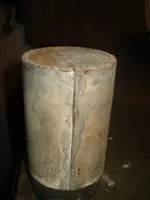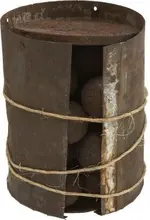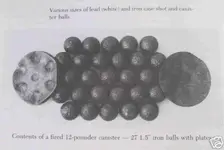mudduck
Jr. Member
- Joined
- Jul 24, 2013
- Messages
- 21
- Reaction score
- 43
- Golden Thread
- 0
- Location
- SOUTHEAST VA
- Detector(s) used
- GARRETT AT PRO; XP DEUS
Potential High Dome Confederate Block I, Schenkl Fuse and a Bunch of Other Stuff!!!
I know this is "Today's Finds," however a lot of times I get home and it is too late and I am too tired to post and then it is back to work.
I wanted to share some things from my past several hunts, including my most recent hunt where I found my first "Block I" and the base plate of a canister shot. Thought for sure that base plate was a buckle or breast plate. That sucker was DEEP.
I am hunting near Richmond, VA.
Earlier I found a Virginia Militia button. Cleaned it up the best I could, that things was brittle.
I found a 12 pounder with small grape shot dimples inside which was cool.
Found a Schenkl Fuse about 3 inches deep in great condition. Not too far away I found the nose of a shell.
It has been a great spring/summer. I did not include all the frags, bullets and misc items (underwear button, etc) I found.
Looking forward to things cooling off and hitting it hard.
Happy hunting!
I know this is "Today's Finds," however a lot of times I get home and it is too late and I am too tired to post and then it is back to work.
I wanted to share some things from my past several hunts, including my most recent hunt where I found my first "Block I" and the base plate of a canister shot. Thought for sure that base plate was a buckle or breast plate. That sucker was DEEP.
I am hunting near Richmond, VA.
Earlier I found a Virginia Militia button. Cleaned it up the best I could, that things was brittle.
I found a 12 pounder with small grape shot dimples inside which was cool.
Found a Schenkl Fuse about 3 inches deep in great condition. Not too far away I found the nose of a shell.
It has been a great spring/summer. I did not include all the frags, bullets and misc items (underwear button, etc) I found.
Looking forward to things cooling off and hitting it hard.
Happy hunting!
Attachments
-
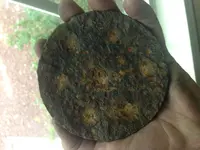 photo 1.webp364.1 KB · Views: 165
photo 1.webp364.1 KB · Views: 165 -
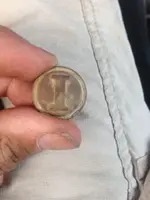 IMG_7653.webp564.3 KB · Views: 171
IMG_7653.webp564.3 KB · Views: 171 -
 IMG_7654.webp533.9 KB · Views: 155
IMG_7654.webp533.9 KB · Views: 155 -
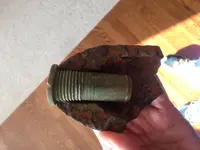 photo.webp247.3 KB · Views: 174
photo.webp247.3 KB · Views: 174 -
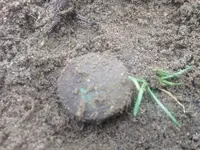 photo 1-3.webp752.1 KB · Views: 139
photo 1-3.webp752.1 KB · Views: 139 -
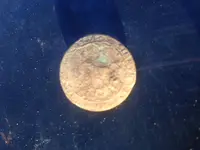 photo 4.webp300.7 KB · Views: 158
photo 4.webp300.7 KB · Views: 158 -
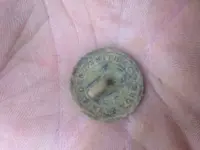 photo 2-2.webp226.6 KB · Views: 129
photo 2-2.webp226.6 KB · Views: 129 -
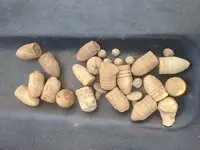 photo 3.webp556.5 KB · Views: 139
photo 3.webp556.5 KB · Views: 139 -
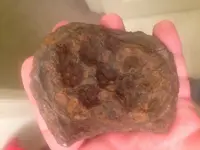 photo-2.webp472.7 KB · Views: 128
photo-2.webp472.7 KB · Views: 128 -
 photo.PNG.webp6.6 KB · Views: 112
photo.PNG.webp6.6 KB · Views: 112
Last edited:
Upvote
10



 actually if that block I is a "high dome" variant it I would nominate it banner though I do not think folks on t-net would understand how exceedingly rare a "high dome" block I is. I am pretty sure it is though but I can be mistaken. If memory serves me correctly they are attributed to being made in New Orleans. I specialize in CS buttons but I have never owned or even handled a "high dome" block letter button before. Huge congrats regardless....
actually if that block I is a "high dome" variant it I would nominate it banner though I do not think folks on t-net would understand how exceedingly rare a "high dome" block I is. I am pretty sure it is though but I can be mistaken. If memory serves me correctly they are attributed to being made in New Orleans. I specialize in CS buttons but I have never owned or even handled a "high dome" block letter button before. Huge congrats regardless....